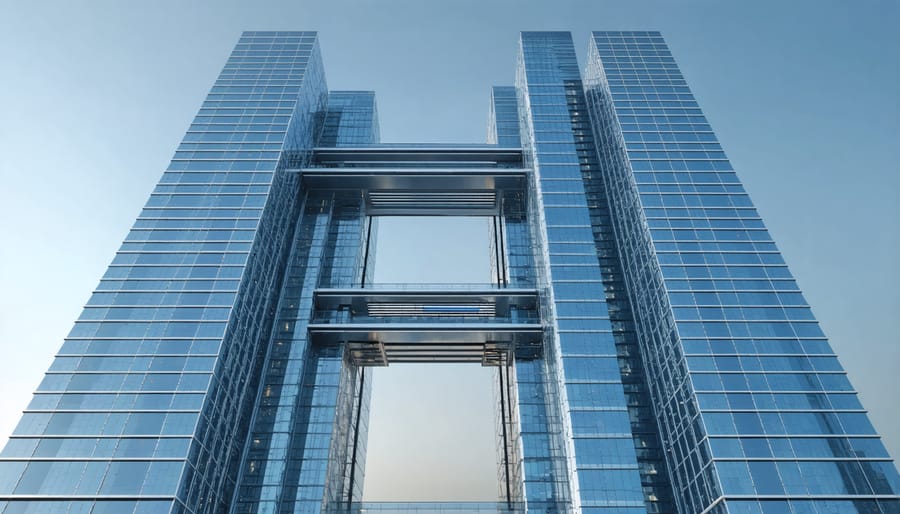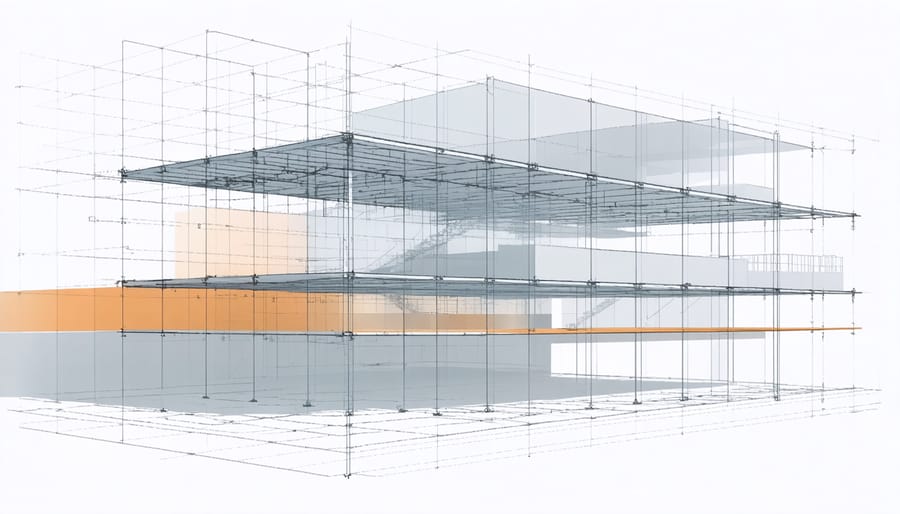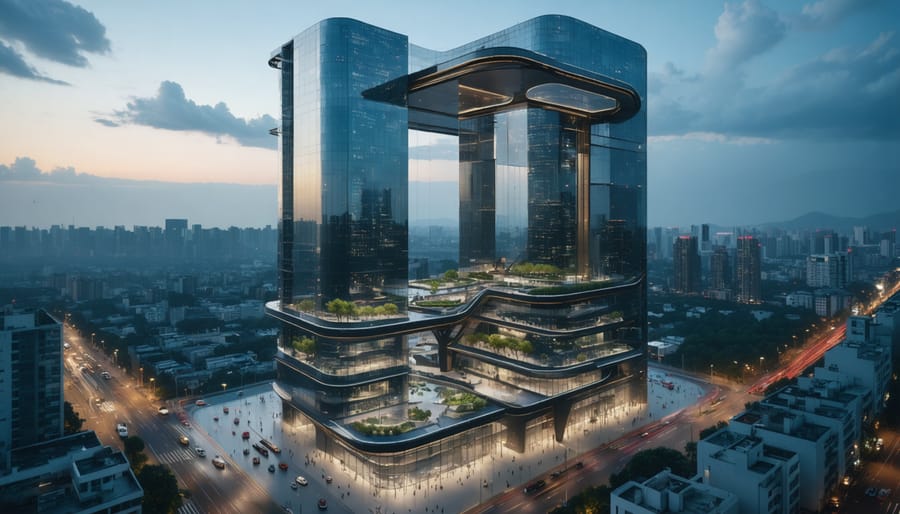In an era of intensifying climate challenges and evolving project demands, resilient technology in construction has become fundamental to building success. The construction industry faces unprecedented pressures – from extreme weather events and resource scarcity to rapid technological advancement and shifting regulatory landscapes. Modern construction resilience transcends traditional building practices, encompassing adaptive design strategies, innovative materials, and intelligent systems integration.
Leading construction firms worldwide are reimagining infrastructure development through a resilience lens, implementing robust solutions that ensure buildings not only withstand environmental stressors but also adapt and thrive across their lifecycle. This systematic approach to resilience incorporates advanced risk assessment methodologies, climate-responsive architectural elements, and smart monitoring systems that predict and prevent potential failures before they occur.
The economic implications are compelling: resilient construction practices typically deliver a 5-15% premium in property values while reducing maintenance costs by up to 25% over traditional buildings. As regulatory frameworks evolve and climate risks intensify, the ability to design, construct, and maintain resilient structures has become a critical competitive advantage in the global construction marketplace.
This comprehensive examination explores cutting-edge resilience strategies, from innovative material technologies to integrated digital solutions, providing practical insights for construction professionals seeking to enhance project durability and long-term value proposition.
The Evolution of Resilient Construction
From Traditional to Smart Materials
The evolution of construction materials marks a significant shift from conventional building elements to innovative smart materials designed for enhanced resilience. Traditional materials like concrete, steel, and timber have undergone substantial modifications through advanced engineering and nanotechnology. Modern concrete formulations now incorporate self-healing capabilities through embedded bacteria or polymers that activate when cracks form. Similarly, high-performance steel alloys offer superior strength-to-weight ratios and improved corrosion resistance.
Smart materials represent the cutting edge of this evolution, featuring properties that respond dynamically to environmental conditions. Phase-changing materials regulate building temperature by absorbing or releasing heat, while piezoelectric materials generate electricity from mechanical stress. Shape-memory alloys return to predetermined forms after deformation, enabling structures to self-correct under stress.
These advancements extend to composite materials that combine multiple properties, such as fiber-reinforced polymers offering exceptional durability and lightweight characteristics. The integration of sensors and smart coating technologies further enhances material performance, enabling real-time monitoring of structural health and environmental adaptation, fundamentally transforming how buildings respond to external challenges and maintain long-term resilience.

Digital Integration in Resilient Design
The integration of digital technologies has become fundamental in developing resilient construction practices. Advanced data analytics, Building Information Modeling (BIM), and digital twin technology now enable construction teams to predict, monitor, and respond to potential vulnerabilities throughout a structure’s lifecycle. These digital tools facilitate real-time monitoring of structural integrity, environmental conditions, and material performance, allowing for proactive maintenance and risk mitigation.
IoT sensors and AI-driven analytics platforms provide continuous data streams that inform decision-making processes, from material selection to structural adjustments. This digital ecosystem helps identify potential failure points before they become critical issues, while machine learning algorithms analyze historical data to improve future resilience strategies.
Cloud-based collaboration platforms ensure that resilience-related information is accessible to all stakeholders, enabling rapid response to emerging challenges. These digital solutions also support adaptive design processes, allowing structures to evolve in response to changing environmental conditions and usage patterns, ultimately creating more resilient and sustainable built environments.
Core Components of Resilient Construction
Structural Innovation
Modern structural innovation has revolutionized how we approach building resilience, introducing advanced systems that significantly enhance a structure’s ability to withstand various environmental and man-made challenges. Performance-based design principles now integrate sophisticated computer modeling and materials science to create buildings that can actively respond to stress rather than merely resist it.
Adaptive structural systems, incorporating smart materials and dynamic load distribution mechanisms, represent a significant advancement in resilient construction. These systems can automatically adjust to changing conditions, redistributing forces during extreme events like earthquakes or high winds. Base isolation technology, for instance, has proven particularly effective in seismic regions, allowing buildings to move independently from their foundations during ground motion.
Mass damping systems and tuned liquid dampers have become increasingly common in tall structures, effectively reducing building sway and vibration. These innovations are complemented by high-performance materials such as ultra-high-strength concrete, carbon fiber composites, and engineered wood products that offer superior strength-to-weight ratios and enhanced durability.
The integration of parametric design tools with Building Information Modeling (BIM) has enabled engineers to optimize structural systems for maximum resilience while maintaining cost-effectiveness. This approach allows for rapid iteration and testing of different structural configurations, ensuring optimal performance under various stress scenarios. Additionally, the emergence of self-healing materials and smart sensors provides real-time monitoring capabilities, allowing structures to identify and address potential vulnerabilities before they become critical issues.

Material Science Breakthroughs
Recent advancements in innovative building materials have revolutionized the construction industry’s approach to resilience. Self-healing concrete, incorporating specialized bacteria that activate when cracks form, represents a significant breakthrough in structural longevity. This biomimetic material can seal fissures up to 0.8mm wide, dramatically reducing maintenance requirements and extending infrastructure lifespan.
Graphene-enhanced composites have emerged as game-changers in structural strength and durability. These materials exhibit exceptional tensile strength—up to 200 times stronger than traditional steel—while maintaining remarkable flexibility. When incorporated into concrete mixtures, graphene creates structures with superior resistance to environmental stressors and seismic activity.
Advanced polymer-modified ceramics now offer unprecedented fire resistance, with some variants maintaining structural integrity at temperatures exceeding 1000°C. These materials integrate seamlessly with conventional construction methods while providing enhanced safety features critical for high-rise buildings and industrial facilities.
Phase-change materials (PCMs) represent another breakthrough, offering passive temperature regulation capabilities. When integrated into building envelopes, PCMs can reduce energy consumption by up to 30% while maintaining stable indoor environments during extreme weather events.
Nano-engineered materials, particularly those incorporating carbon nanotubes, demonstrate exceptional potential for creating lighter yet stronger structural elements. These materials offer improved thermal conductivity and electrical properties, enabling smart monitoring capabilities within the structural elements themselves.

Environmental Adaptation Systems
Environmental adaptation systems represent a crucial component of construction resilience, enabling buildings to respond dynamically to changing environmental conditions. These systems integrate smart technologies and sustainable design principles to maintain optimal performance regardless of external challenges.
Advanced building envelope systems incorporate adaptive facades with automated shading devices, electrochromic glazing, and dynamic insulation that adjusts to temperature fluctuations. These elements work in concert to regulate internal conditions while minimizing energy consumption.
Rainwater harvesting and greywater recycling systems have evolved to include sophisticated filtration and distribution networks, enabling buildings to maintain water security during drought conditions. Smart sensors monitor water quality and usage patterns, automatically adjusting collection and distribution based on demand and environmental conditions.
Climate-responsive HVAC systems utilize predictive analytics and weather monitoring to anticipate and adapt to changing conditions. These systems often incorporate geothermal heat exchange and thermal mass solutions to maintain comfort levels while reducing energy requirements.
Green infrastructure elements, such as living walls and bioswales, serve dual purposes by providing natural cooling and managing stormwater runoff. These systems are increasingly being integrated with building management platforms that optimize their performance based on real-time environmental data.
Recent implementations in commercial buildings have demonstrated energy savings of up to 40% through environmental adaptation systems, while significantly improving occupant comfort and building durability. The integration of these technologies represents a fundamental shift toward more resilient and sustainable construction practices.
Implementation Strategies
Risk Assessment and Planning
Effective risk assessment and planning form the cornerstone of construction resilience, requiring a systematic approach to identify, evaluate, and mitigate potential threats to construction projects. The process begins with comprehensive vulnerability assessments that examine both physical and operational risks, including natural disasters, climate change impacts, and structural vulnerabilities.
Modern risk assessment methodologies incorporate advanced modeling techniques and data analytics to predict potential failure points and assess their likelihood and impact. These assessments must align with current infrastructure resilience standards while considering site-specific challenges and regulatory requirements.
Key components of resilience planning include:
– Detailed hazard mapping and risk matrices
– Structural vulnerability assessments
– Supply chain disruption analysis
– Emergency response protocols
– Business continuity planning
Project teams should implement a multi-layered approach to risk mitigation, incorporating both preventive measures and adaptive strategies. This includes designing redundancy into critical systems, selecting appropriate materials and construction methods, and establishing clear communication protocols for emergency situations.
Regular updates to risk assessments ensure that planning remains current with emerging threats and changing environmental conditions. Documentation and sharing of risk assessment findings across project stakeholders helps maintain alignment and ensures comprehensive implementation of resilience measures.
Integration with Existing Infrastructure
Integrating resilient technologies into existing infrastructure requires a strategic approach that balances innovation with practicality. The process typically begins with a comprehensive structural assessment to identify vulnerabilities and determine suitable retrofit options. This evaluation should consider both the building’s current condition and its projected performance under various stress scenarios.
Key integration strategies include the implementation of smart monitoring systems, which can be retrofitted to existing structures through wireless sensor networks. These systems provide real-time data on structural integrity, environmental conditions, and potential risks. Additionally, strengthening existing foundations and load-bearing elements often involves advanced composite materials that can be applied without significant disruption to building operations.
The adaptation of existing mechanical and electrical systems plays a crucial role in enhancing resilience. Modern building management systems can be integrated with legacy infrastructure through middleware solutions, enabling better control over critical systems during extreme events. Energy efficiency improvements can be achieved through the installation of smart meters, automated controls, and renewable energy systems that complement existing power infrastructure.
For successful integration, project teams should develop a phased implementation plan that minimizes disruption to ongoing operations. This typically involves careful scheduling of retrofits during off-peak hours and maintaining redundant systems during transitions. Cost-effective solutions might include modular upgrades that can be implemented incrementally as budgets allow.
Regular monitoring and maintenance protocols must be established to ensure the long-term effectiveness of these resilient technologies. This includes training facility managers and maintenance staff on new systems and establishing clear procedures for emergency responses.
Cost-Benefit Analysis
The implementation of resilient construction practices requires substantial upfront investment, but the long-term benefits often outweigh initial costs. According to industry research, resilient buildings typically command 7-10% higher market values and demonstrate reduced operational costs over their lifecycle. When analyzing construction project metrics, resilient structures show a 15-30% reduction in maintenance expenses and significantly lower insurance premiums.
A comprehensive cost-benefit analysis must consider multiple factors: initial construction costs, potential disaster-related savings, operational efficiency gains, and increased property value. Studies indicate that every dollar invested in resilience yields an average return of $4-7 in avoided disaster costs. For commercial buildings, enhanced resilience features typically represent a 3-5% premium in construction costs but can reduce annual operating costs by up to 20%.
Insurance companies increasingly offer preferential rates for resilient buildings, recognizing their reduced risk profile. Furthermore, buildings with documented resilience measures often experience shorter vacancy periods and higher tenant retention rates. The ROI calculation should also factor in business continuity benefits, as resilient structures minimize downtime during and after extreme events, protecting revenue streams and maintaining operational capabilities.
When considering lifecycle costs, resilient construction demonstrates superior economic performance through reduced repair needs, lower energy consumption, and enhanced durability, typically achieving break-even within 5-7 years of construction.
Case Studies in Construction Resilience
Commercial Success Stories
Several notable commercial projects have demonstrated exceptional resilience in recent years, setting new standards for the industry. The 181 Fremont Tower in San Francisco exemplifies seismic resilience through its innovative megabrace system and viscous damping devices, enabling the structure to withstand major earthquakes while maintaining operational capability. The building’s performance during simulation testing showed a 50% reduction in lateral movement compared to conventional designs.
The Edge building in Amsterdam showcases environmental resilience through its integrated smart systems and sustainable design. With 28,000 sensors managing everything from occupancy to energy consumption, the building achieved the highest BREEAM sustainability score ever recorded, while demonstrating remarkable operational resilience during extreme weather events.
In Miami, the recently completed 830 Brickell office tower incorporates hurricane-resistant design features, including impact-resistant glazing systems capable of withstanding Category 5 hurricane forces. The building’s envelope system has been tested to pressures exceeding 100 psf, while its backup power systems ensure business continuity during extended outages.
The International Quarter London (IQL) development demonstrates social resilience through its adaptive mixed-use design. During the COVID-19 pandemic, the project’s flexible spaces and advanced ventilation systems allowed for quick adaptation to changing occupancy patterns and health requirements, maintaining 85% occupancy rates when similar properties averaged 40%.
These projects highlight how integrated resilience strategies deliver both immediate and long-term benefits, combining disaster preparedness with operational efficiency and sustainability. Their success has influenced building codes and industry standards, driving broader adoption of resilient construction practices.

Infrastructure Applications
Infrastructure projects exemplify the critical importance of resilience in construction, with numerous successful implementations worldwide. The San Francisco-Oakland Bay Bridge’s eastern span reconstruction demonstrates how seismic resilience can be integrated into major transportation infrastructure. The bridge’s design incorporates specialized shock absorbers and flexible joints that allow movement during earthquakes while maintaining structural integrity.
In water infrastructure, the Rotterdam Climate Proof program showcases innovative flood resilience strategies. The city implemented water squares that serve as recreational areas during dry weather but transform into water retention basins during heavy rainfall events. This dual-purpose design maximizes infrastructure efficiency while protecting against climate-related risks.
The Crossrail project in London exemplifies resilience through redundancy and adaptability. The underground railway system features flood-resistant entrance designs, backup power systems, and climate-controlled ventilation systems that can operate independently during emergencies. These elements ensure continuous service even under adverse conditions.
In telecommunications infrastructure, the AT&T Network Disaster Recovery program demonstrates how critical communications facilities can maintain operations during extreme events. Their mobile recovery units and redundant routing systems ensure network continuity during natural disasters or other disruptions.
Energy infrastructure projects have also embraced resilience principles. The Con Edison Resilient Grid program in New York City implemented submersible electrical equipment, elevated critical systems above flood levels, and created smart grid technologies that can isolate damaged sections while maintaining power to unaffected areas.
These examples highlight how infrastructure resilience requires both physical reinforcement and operational flexibility, creating systems that can withstand, adapt to, and rapidly recover from disruptive events.
The evolution of construction resilience continues to reshape our approach to building design and development, driven by technological advances and growing environmental challenges. As we’ve explored throughout this article, the integration of smart materials, adaptive designs, and innovative construction methodologies has become crucial for creating structures that can withstand and recover from diverse threats.
The future of resilient construction lies in the convergence of digital technologies and sustainable practices. Artificial Intelligence and machine learning are enabling more accurate prediction of structural behavior under stress, while advanced monitoring systems provide real-time data on building performance. These technologies, combined with emerging materials like self-healing concrete and carbon-fiber composites, are setting new standards for structural durability and adaptability.
Industry leaders are increasingly recognizing that resilience is not just about structural integrity but encompasses economic and environmental sustainability. The adoption of circular economy principles in construction, coupled with energy-efficient designs, is creating buildings that are both robust and environmentally responsible.
Looking ahead, we can expect to see greater emphasis on modular and adaptable construction techniques that allow buildings to evolve with changing needs and environmental conditions. The integration of renewable energy systems and smart grid technologies will become standard features of resilient buildings, ensuring operational continuity during disruptions.
For construction professionals, staying informed about these developments and incorporating resilient design principles into projects is no longer optional but essential. Success in the future construction industry will depend on the ability to balance innovative technologies with practical implementation, ensuring buildings are not just constructed to last but designed to thrive in an increasingly unpredictable world.

